What Markets Indicate We Can Expect In 2020
As we come to the close of another quarter, we want to share a high-level overview of what we’re seeing across the industry, and what we think the market is going to do for upcoming renewals this year. Use the links below to jump to any one of the sections featured in this report. We’ll cover the following:
- Upstream Energy
- Midstream Energy
- Downstream Energy
- Power and Renewables
- Energy Casualty
- Energy Surety
For any questions, please don’t hesitate to reach out to Nikki Howes and EPIC’s National Energy Practice.
EPIC National Energy Practice
With over 100+ years of combined experience, the EPIC Specialty National Energy Team, based in Houston, can successfully market and service all aspects of energy business and maintain important client relationships. Our expertise in the Upstream, Midstream and Downstream sectors, combined with our incredible market relationships, allow us to offer energy insurance solutions that are second to none.
Upstream Energy
Key Points:
- No significant upstream catastrophe losses impacting the Energy underwriting market for over 10 years – generally good loss ratios for insurers.
- Capacity is at an all-time high, greater than $7BN and extremely financially sound. Lloyds has approved increased capacity for the top performing syndicates.
- New entrant, Convex has $350M upstream capacity- adding pressure on smaller and medium size players.
- U.S. Onshore upstream have shown an unexpectedly high number of OEE losses in 2019, ranging from $20M – $50M, leading to a deterioration in results for some underwriters.
- General underwriting trend still seeking rate increases of 2.5-5% for favorable risks in Q1 2020 as rates are still historically low while premiums less than 50% of the 2014 high. Loss impacted risks are expecting increases of 10-30%. US operators are being particularly impacted by poor loss records.
- Shale operators and contractors are seeing dramatic increases in deductibles and rates.
- Offshore construction rates have nearly tripled from early 2019 due to losses in this sector, and programs valued over $5BN will prove challenging to complete.
- Land rig and Equipment is expected to continue increased rates of 7.5-10%
- Market moving towards a hardening phase, now tougher to get “free” exposures thrown in, such as adding to values at no premium.
- Challenges include obtaining accommodating terms and conditions that were previously readily available. Tendency in the market to remove coverage extensions and offer them back for additional premium.
- The process is taking more time, getting an early start will be imperative.
Midstream Energy
Key Points:
- Private Equity capital being heavily directed toward midstream due to the economic environment and relative lack of volatility in the industry.
- Key factors in Midstream underwriting:
- Age of assets
- Asset Maintenance
- Controlling catastrophe aggregation
- Industry expecting 10-25% increases depending on sector and asset base.
- Retentions increasing, minimum thresholds of $25,000.
- Midstream accounts are increasingly being underwritten into the Upstream market.
- Terms and conditions are a major focus.
- Auto Liability for haulers is extremely volatile and seeing very few available markets with heavy increases.
Downstream Energy
Key Points:
- Severe Losses impacting the Downstream energy book (spanning all downstream sectors) in 2019 of over $4.2BN; more losses in the $100-$100M range; Losses declining but have destabilized the market with third consecutive year of negative loss ratios.
- 2017: $6.5BN
- 2018: $4.4BN
- 2019 $4.2BN (projected)
- The aggregated global losses are in excess of $15BN, against gross premiums of less than 50% of the losses.
- Reinsurance program retentions increasing.
- Capacity in downstream energy down (to $6.25BN in the US from $6.5BN) for first time since 2002- critical capacity levels down by ~20%.
- Divided approach: some giving rate increases at once while others giving stair-stepped rate increase approach.
- Lloyds not allowing syndicates to increase capacity.
- 30%+ increases expected for refining accounts, more for loss impacted clients at 40-60%.
- Supply/Demand balance has shifted, leading to higher increases.
- Focus on Business Interruption values and asset values; Increased scrutiny of undervaluations and attachment points.
- Some insurers imposing Business Interruption caps to contain volatility.
Power/Renewables
Key Points:
- Single largest renewable energy claim in 2019 at $75M; A hail event at a solar PV site in the U.S.
- CNA Hardy and Pioneer syndicates have closed their renewable classes.
- Whereas the three largest syndicates in power gen, Axis, Gcube and RSA, normally signed 100%, their capacity has reduced to taking quota share of no more than 50%
- Power has been a tough class with underwriters struggling to be profitable; London market seeing a tightening of capacity and realignment of their capacity to more profitable areas. Market is seeing hardening over the last 6 months.
- Loss free accounts are seeing a 12.5-15% rate increase- those with catastrophe exposure or losses are seeing higher increases, compounded with increased retentions.
- Deductibles and retentions holding steady on loss free accounts.
- Most important for clients to differentiate themselves from their peers.
- One of the biggest threats to this massive emerging market is cyber security and weather volatility.
- California wildfires a major threat, and often being excluded from General Liability policies.
Energy Casualty
Key Points:
- Energy casualty is most often lumped in with other liability segments and losses are not differentiated between energy and non-energy. The wider market segment has suffered a series of catastrophic events that affects the casualty industry as a whole.
- Natural catastrophes such as wildfires in U.S. and Australia, as well as Hurricanes Harvey, Irma, and Marie.
- Mass shooting events such as the 2017 hotel sniper event
- Marine yacht losses
- U.S. auto losses
- Social inflation
- Capacity is contracting, especially in the Excess lines
- Layers reduced, adding need to bring in new carriers
- Terms and conditions scrutinized more closely
- All capacity is being deployed more conservatively and selectively
- Difficult to harmonize premium thresholds across industries; loss ratios from all liability hits energy underwriters as well.
- Severity of auto liability claims driving auto rates up 20-35%, more for accounts with losses.
- Damages rising exponentially due to sympathetic juries and their need to “punish” corporations
- Commercial drivers aging out of the workforce without replacement leading to driver shortages and lack of experienced drivers
- Technologies and distracted driving
- Markets are increasingly hesitant to write an account without supporting lines such as Workers’ Compensation, and Auto Liability is extremely limited on a monoline basis.
- The shift in casualty pricing began in 2018 and we estimate it should level out around mid-2020 after loss-free accounts have seen their share of the increases needed.
Energy Surety
Key Points:
- EPIC’s full scale surety operations are up and running with offices in Houston, Dallas, and San Antonio.
- Capable of providing bonds for all aspects of the energy industry.
- As underwriters continue to have good loss ratios in the oil and gas space, we are seeing more commercial surety markets emerge, either with existing major insurance companies or more niche insurance firms focused on energy and looking for the following:
- Upstream
- Plugging and Abandonment Bonds
- License and Permit Bonds
- All Federal and State surety obligations
- Midstream
- ROW Bonds
- Firm Transportation Agreement Bonds
- Downstream
- Closure / Post-Closure Bonds
- Supply Bonds
- Large construction surety claims on several high profile projects, including the Bondfield Hospitals in Canada and the Hard Rock Hotel in New Orleans.
- Not expected to disrupt underwriter’s appetite of performance and payment bonds in the energy industry.
- The Firm Transportation Bond continues to gain popularity as a replacement for letters of credit that secure various midstream throughput agreements.
- Expertise in looking into a company’s bond and letter of credit portfolio and identifying immediate cost savings measures.
- No update to the Gulf of Mexico NTL regarding financial assurance. Trump administration halted Obama era regulations but has yet to institute new laws regarding financial assurance.
- Surety Brokers in Houston are renowned leaders in Gulf of Mexico bonds with BOEM, and all onshore obligations.
- We maintain close relationships with BOEM officials and New Orleans attorneys to stay as knowledgeable as possible on any NTL updates.
- Tremendous demand for North Sea Decommissioning financial assurance. £2 billion in decommissioning spend expected in the next decade.
- We have found the U.S. surety market to be much more aggressive than the European market for these bonds and we expect North Sea operators to look to the U.S. for the coverage they require.
- Upstream
Related Content
Industries
Energy
Put your trust in the team that knows energy insurance solutions. With a variety of onshore and offshore ...
Products
Risk Management
Our experienced teams take an enterprise-wide approach, consulting closely with you to identify, analyze and ...
Products
Employee Benefits Consulting
Our dedicated benefits team is focused on delivering better outcomes – to both your benefits program and ...



